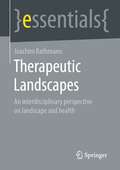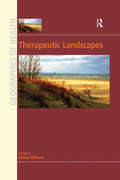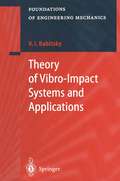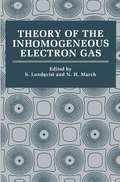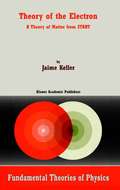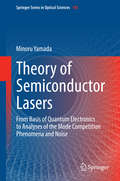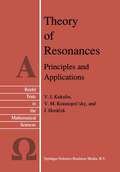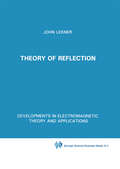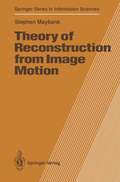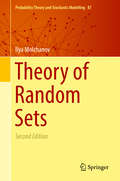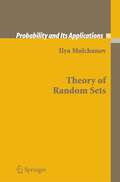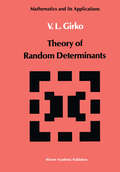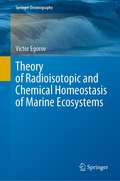- Table View
- List View
Therapeutic Landscapes: An Interdisciplinary Perspective on Landscape and Health (essentials)
by Joachim RathmannJoachim Rathmann presents the interdisciplinary relationships between landscapes and health. Nature is to be regarded as an elementary health resource, because movement in near-natural surroundings has demonstrably positive influences on human health and is summarized in many ways in the concept of "therapeutic landscapes". Natural areas offer an important resource for strengthening health, especially to an aging society, which can also be measured economically. The author presents natural science, social science, and humanities research in a clear, understandable, and concise manner for a broad readership. At the same time he gives suggestions for a conscious handling of the sensitive resource landscape and for a regular observation of nature. This springer essential is a translation of the original German 1st edition essentials,Therapeutic landscapes by Joachim Rathmann, published by Springer Fachmedien Wiesbaden GmbH, part of Springer Nature in 2020.The translation was done with the help of artificial intelligence (machine translation by the service DeepL.com). A subsequent human revision was done primarily in terms of content, so that the book will read stylistically differently from a conventional translation. Springer Nature works continuously to further the development of tools for the production of books and on the related technologies to support the authors.
Therapeutic Landscapes (Geographies of Health Series)
by Allison WilliamsThe therapeutic landscape concept, first introduced early in the 1990s, has been widely employed in health/medical geography and gaining momentum in various health-related disciplines. This is the first book published in several years, and provides an introduction to the concept and its applications. Written by health/medical geographers and anthropologists, it addresses contemporary applications in the natural and built environments; for special populations, such as substance abusers; and in health care sites, a new and evolving area - and provides an array of critiques or contestations of the concept and its various applications. The conclusion of the work provides a critical evaluation of the development and progress of the concept to date, signposting the likely avenues for future investigation.
Therapeutic Landscapes (Geographies of Health Series)
by Allison WilliamsThe therapeutic landscape concept, first introduced early in the 1990s, has been widely employed in health/medical geography and gaining momentum in various health-related disciplines. This is the first book published in several years, and provides an introduction to the concept and its applications. Written by health/medical geographers and anthropologists, it addresses contemporary applications in the natural and built environments; for special populations, such as substance abusers; and in health care sites, a new and evolving area - and provides an array of critiques or contestations of the concept and its various applications. The conclusion of the work provides a critical evaluation of the development and progress of the concept to date, signposting the likely avenues for future investigation.
Theory of Vibro-Impact Systems and Applications (Foundations of Engineering Mechanics)
by Vladimir I. Babitsky- Models of vibro-impact systems are widely used in machine dynamics, vibration engineering, and structural mechanics. - Only monograph on this subject in English language. - Systematically presents the theory of vibro-impact systems by analysis of typical engineering applications. - Experimental data and computer simulations are presented. - Targeted to engineers and researchers in design and investigation of mechanical systems as well as to lecturers and advanced students.
The Theory of Turbulence: Subrahmanyan Chandrasekhar's 1954 Lectures (Lecture Notes in Physics #810)
by Edward A. SpiegelIn January 1937, Nobel laureate in Physics Subrahmanyan Chandrasekhar was recruited to the University of Chicago. He was to remain there for his entire career, becoming Morton D. Hull Distinguished Service Professor of Theoretical Astrophysics in 1952 and attaining emeritus status in 1985. This is where his then student Ed Spiegel met him during the summer of 1954, attended his lectures on turbulence and jotted down the notes in hand. His lectures had a twofold purpose: they not only provided a very elementary introduction to some aspects of the subject for novices, they also allowed Chandra to organize his thoughts in preparation to formulating his attack on the statistical problem of homogeneous turbulence. After each lecture Ed Spiegel transcribed the notes and filled in the details of the derivations that Chandrasekhar had not included, trying to preserve the spirit of his presentation and even adding some of his side remarks. The lectures were rather impromptu and the notes as presented here are as they were set down originally in 1954. Now they are being made generally available for Chandrasekhar’s centennial.
Theory of Thermodynamic Measurements of Quantum Systems Far from Equilibrium (Springer Theses)
by Abhay ShastryThis thesis presents several related advances in the field of nonequilibrium quantum thermodynamics. The central result is an ingenious proof that the local temperature and voltage measurement in a nonequilibrium system of fermions exists and is unique, placing the concept of local temperature on a rigorous mathematical footing for the first time. As an intermediate step, a proof of the positivity of the Onsager matrix of linear response theory is given -- a statement of the second law of thermodynamics that had lacked an independent proof for 85 years. A new experimental method to measure the local temperature of an electron system using purely electrical techniques is also proposed, which could enable improvements to the spatial resolution of thermometry by several orders of magnitude. Finally, a new mathematically-exact definition for the local entropy of a quantum system in a nonequilibrium steady state is derived. Several different measures of the local entropy are discussed, relating to the thermodynamics of processes that a local observer with varying degrees of information about the microstates of the system could carry out, and it is shown that they satisfy a hierarchy of inequalities. Proofs of the third law of thermodynamics for generic open quantum systems are presented, taking into account the entropic contribution due to localized states. Appropriately normalized (per-state) local entropies are defined and are used to quantify the departure from local equilibrium.
The Theory of the Top. Volume IV: Technical Applications of the Theory of the Top
by Felix Klein Arnold SommerfeldThe Theory of the Top was originally presented by Felix Klein as an 1895 lecture at Göttingen University that was broadened in scope and clarified as a result of collaboration with Arnold Sommerfeld. The Theory of the Top: Volume IV. Technical Applications of the Theory of the Top is the fourth and final installment in a series of self-contained English translations that provide insights into kinetic theory and kinematics.
The Theory of the Top Volume III: Perturbations. Astronomical and Geophysical Applications
by Felix Klein Arnold SommerfeldThe Theory of the Top was originally presented by Felix Klein as an 1895 lecture at Göttingen University that was broadened in scope and clarified as a result of collaboration with Arnold Sommerfeld. The Theory of the Top: Volume III. Perturbations: Astronomical and Geophysical Applications is the third installment in a series of four self-contained English translations that provide insights into kinetic theory and kinematics.
The Theory of the Top. Volume II: Development of the Theory in the Case of the Heavy Symmetric Top
by Felix Klein Arnold SommerfeldThe Theory of the Top. Volume II. Development of the Theory in the Case of the Heavy Symmetric Top is the second in a series of four self-contained English translations of the classic and definitive treatment of rigid body motion. Graduate students and researchers interested in theoretical and applied mechanics will find this a thorough and insightful account. Other works in this series include Volume I. Introduction to the Kinematics and Kinetics of the Top, Volume III. Perturbations. Astronomical and Geophysical Applications, and Volume IV. Technical Applications of the Theory of the Top.
The Theory of the Top. Volume I: Introduction to the Kinematics and Kinetics of the Top
by Felix Klein Arnold SommerfeldThe lecture series on the Theory of the Top was originally given as a dedication to Göttingen University by Felix Klein in 1895, but has since found broader appeal. The Theory of the Top: Volume I. Introduction to the Kinematics and Kinetics of the Top is the first of a series of four self-contained English translations that provide insights into kinetic theory and kinematics.
Theory of the Nuclear Magnetic 1/T1 Relaxation Rate in Conventional and Unconventional Magnets (Springer Theses)
by Andrew SmeraldOne of the best ways to "lift the lid" on what is happening inside a given material is to study it using nuclear magnetic resonance (NMR). Of particular interest are NMR 1/T1 relaxation rates, which measure how fast energy stored in magnetic nuclei is transferred to surrounding electrons. This thesis develops a detailed, quantitative theory of NMR 1/T1 relaxation rates, and shows for the first time how they could be used to measure the speed at which energy travels in a wide range of magnetic materials. This theory is used to make predictions for"Quantum Spin Nematics", an exotic form of quantum order analogous to a liquid crystal. In order to do so, it is first necessary to unravel how spin nematics transport energy. This thesis proposes a new way to do this, based on the description of quarks in high-energy physics. Experiments to test the ideas presented are now underway in laboratories across the world.
Theory of the Inhomogeneous Electron Gas (Physics of Solids and Liquids)
by Stig Lundqvist Norman H. MarchThe theory of the inhomogeneous electron gas had its origin in the Thomas Fermi statistical theory, which is discussed in the first chapter of this book. This already leads to significant physical results for the binding energies of atomic ions, though because it leaves out shell structure the results of such a theory cannot reflect the richness of the Periodic Table. Therefore, for a long time, the earlier method proposed by Hartree, in which each electron is assigned its own personal wave function and energy, dominated atomic theory. The extension of the Hartree theory by Fock, to include exchange, had its parallel in the density description when Dirac showed how to incorporate exchange in the Thomas-Fermi theory. Considerably later, in 1951, Slater, in an important paper, showed how a result similar to but not identical with that of Dirac followed as a simplification of the Hartree-Fock method. It was Gombas and other workers who recognized that one could also incorporate electron correlation consistently into the Thomas-Fermi-Dirac theory by using uniform electron gas relations locally, and progress had been made along all these avenues by the 1950s.
Theory of the Electron: A Theory of Matter from START (Fundamental Theories of Physics #115)
by J. KellerIn the first century after its discovery, the electron has come to be a fundamental element in the analysis of physical aspects of nature. This book is devoted to the construction of a deductive theory of the electron, starting from first principles and using a simple mathematical tool, geometric analysis. Its purpose is to present a comprehensive theory of the electron to the point where a connection can be made with the main approaches to the study of the electron in physics. The introduction describes the methodology. Chapter 2 presents the concept of space-time-action relativity theory and in chapter 3 the mathematical structures describing action are analyzed. Chapters 4, 5, and 6 deal with the theory of the electron in a series of aspects where the geometrical analysis is more relevant. Finally in chapter 7 the form of geometrical analysis used in the book is presented to elucidate the broad range of topics which are covered and the range of mathematical structures which are implicitly or explicitly included. The book is directed to two different audiences of graduate students and research scientists: primarily to theoretical physicists in the field of electron physics as well as those in the more general field of quantum mechanics, elementary particle physics, and general relativity; secondly, to mathematicians in the field of geometric analysis.
Theory of Stochastic Differential Equations with Jumps and Applications: Mathematical and Analytical Techniques with Applications to Engineering (Mathematical and Analytical Techniques with Applications to Engineering)
by Rong SITUStochastic differential equations (SDEs) are a powerful tool in science, mathematics, economics and finance. This book will help the reader to master the basic theory and learn some applications of SDEs. In particular, the reader will be provided with the backward SDE technique for use in research when considering financial problems in the market, and with the reflecting SDE technique to enable study of optimal stochastic population control problems. These two techniques are powerful and efficient, and can also be applied to research in many other problems in nature, science and elsewhere.
Theory of Stellar Atmospheres: An Introduction to Astrophysical Non-equilibrium Quantitative Spectroscopic Analysis
by Ivan Hubeny Dimitri MihalasThis book provides an in-depth and self-contained treatment of the latest advances achieved in quantitative spectroscopic analyses of the observable outer layers of stars and similar objects. Written by two leading researchers in the field, it presents a comprehensive account of both the physical foundations and numerical methods of such analyses. The book is ideal for astronomers who want to acquire deeper insight into the physical foundations of the theory of stellar atmospheres, or who want to learn about modern computational techniques for treating radiative transfer in non-equilibrium situations. It can also serve as a rigorous yet accessible introduction to the discipline for graduate students.Provides a comprehensive, up-to-date account of the fieldCovers computational methods as well as the underlying physicsServes as an ideal reference book for researchers and a rigorous yet accessible textbook for graduate studentsAn online illustration package is available to professors at press.princeton.edu
The Theory of Sprays and Finsler Spaces with Applications in Physics and Biology (Fundamental Theories of Physics #58)
by P.L. Antonelli Roman S. Ingarden M. MatsumotoThe present book has been written by two mathematicians and one physicist: a pure mathematician specializing in Finsler geometry (Makoto Matsumoto), one working in mathematical biology (Peter Antonelli), and a mathematical physicist specializing in information thermodynamics (Roman Ingarden). The main purpose of this book is to present the principles and methods of sprays (path spaces) and Finsler spaces together with examples of applications to physical and life sciences. It is our aim to write an introductory book on Finsler geometry and its applications at a fairly advanced level. It is intended especially for graduate students in pure mathemat ics, science and applied mathematics, but should be also of interest to those pure "Finslerists" who would like to see their subject applied. After more than 70 years of relatively slow development Finsler geometry is now a modern subject with a large body of theorems and techniques and has math ematical content comparable to any field of modern differential geometry. The time has come to say this in full voice, against those who have thought Finsler geometry, because of its computational complexity, is only of marginal interest and with prac tically no interesting applications. Contrary to these outdated fossilized opinions, we believe "the world is Finslerian" in a true sense and we will try to show this in our application in thermodynamics, optics, ecology, evolution and developmental biology. On the other hand, while the complexity of the subject has not disappeared, the modern bundle theoretic approach has increased greatly its understandability.
Theory of Spinors and Its Application in Physics and Mechanics
by Vladimir A. ZhelnorovichThis book contains a systematic exposition of the theory of spinors in finite-dimensional Euclidean and Riemannian spaces. The applications of spinors in field theory and relativistic mechanics of continuous media are considered. The main mathematical part is connected with the study of invariant algebraic and geometric relations between spinors and tensors. The theory of spinors and the methods of the tensor representation of spinors and spinor equations are thoroughly expounded in four-dimensional and three-dimensional spaces. Very useful and important relations are derived that express the derivatives of the spinor fields in terms of the derivatives of various tensor fields.The problems associated with an invariant description of spinors as objects that do not depend on the choice of a coordinate system are addressed in detail. As an application, the author considers an invariant tensor formulation of certain classes of differential spinor equations containing, in particular, the most important spinor equations of field theory and quantum mechanics. Exact solutions of the Einstein–Dirac equations, nonlinear Heisenberg’s spinor equations, and equations for relativistic spin fluids are given. The book presents a large body of factual material and is suited for use as a handbook. It is intended for specialists in theoretical physics, as well as for students and post-graduate students of physical and mathematical specialties.
Theory of Semiconductor Lasers: From Basis of Quantum Electronics to Analyses of the Mode Competition Phenomena and Noise (Springer Series in Optical Sciences #185)
by Minoru YamadaThis book provides a unified and complete theory for semiconductor lasers, covering topics ranging from the principles of classical and quantum mechanics to highly advanced levels for readers who need to analyze the complicated operating characteristics generated in the real application of semiconductor lasers. The author conducts a theoretical analysis especially on the instabilities involved in the operation of semiconductor lasers. A density matrix into the theory for semiconductor lasers is introduced and the formulation of an improved rate equation to help understand the mode competition phenomena which cause the optical external feedback noise is thoroughly described from the basic quantum mechanics. The derivation of the improved rate equation will allow readers to extend the analysis for the different types of semiconductor materials and laser structures they deal with. This book is intended not only for students and academic researchers but also for engineers who develop lasers for the market, as the advanced topics covered are dedicated to real problems in implementing semiconductor lasers for practical use.
Theory of Resonances: Principles and Applications (Reidel Texts in the Mathematical Sciences #3)
by V.I. Kukulin V.M. Krasnopolsky J. HorácekTheory of Reflection of Electromagnetic and Particle Waves (Developments in Electromagnetic Theory and Applications #3)
by John LeknerThis book is written for scientists and engineers whose work involves wave reflec tion or transmission. Most of the book is written in the language of electromagnetic theory, but, as the title suggests, many of the results can be applied to particle waves, specifically to those satisfying the Schr6dinger equation. The mathematical connection between electromagnetic s (or TE) waves and quantum particle waves is established in Chapter 1. The main results for s waves are translated into quantum mechanical language in the Appendix. There is also a close analogy between acoustic waves and electromagnetic p (or TM) waves, as shown in Section 1-4. Thus the book, though primarily intended for those working in optics, microwaves and radio, will be of use to physicists, chemists and electrical engineers studying reflection and transmission of particles at potential barriers. The tech niques developed here can also be used by those working in acoustics, ocean ography and seismology. Chapter 1 is recommended for all readers: it introduces reflection phenomena, defines the notation, and previews (in Section 1-6) the contents of the rest of the book. This preview will not be duplicated here. We note only that applied topics do appear: two examples are the important phenomenon of attenuated total reflection in Chapter 8, and the reflectivity of multilayer dielectric mirrors in Chapter 12. The subject matter is restricted to linear classical electrodynamics in non-magnetic media, and the corresponding particle analogues.
Theory of Reconstruction from Image Motion (Springer Series in Information Sciences #28)
by Stephen MaybankThe image taken by a moving camera changes with time. These image motions contain information about the motion of the camera and about the shapes of the objects in the field of view. There are two main types of image motion, finite displacements and image velocities. Finite displacements are described by the point correspondences between two images of the same scene taken from different positions. Image velocities are the velocities of the points in the image as they move over the projection surface. Reconstruction is the task of obtaining from the image-motions information about the camera motion or about the shapes of objects in the field of view. In this book the theory underlying reconstruction is described. Reconstruction from image motion is the subject matter of two different sci entific disciplines, photogrammetry and computer vision. In photogrammetry the accuracy of reconstruction is emphasised; in computer vision the emphasis is on methods for obtaining information from images in real time in order to guide a mechanical device such as a robot arm or an automatic vehicle. This book arises from recent work carried out in computer vision. Computer vision is a young field but it is developing rapidly. The earliest papers on reconstruction in the computer vision literature date back only to the mid 1970s. As computer vision develops, the mathematical techniques applied to the analysis of recon struction become more appropriate and more powerful.
Theory of Random Sets (Probability Theory and Stochastic Modelling #87)
by Ilya MolchanovThis monograph, now in a thoroughly revised second edition, offers the latest research on random sets. It has been extended to include substantial developments achieved since 2005, some of them motivated by applications of random sets to econometrics and finance. The present volume builds on the foundations laid by Matheron and others, including the vast advances in stochastic geometry, probability theory, set-valued analysis, and statistical inference. It shows the various interdisciplinary relationships of random set theory within other parts of mathematics, and at the same time fixes terminology and notation that often vary in the literature, establishing it as a natural part of modern probability theory and providing a platform for future development. It is completely self-contained, systematic and exhaustive, with the full proofs that are necessary to gain insight. Aimed at research level, Theory of Random Sets will be an invaluable reference for probabilists; mathematicians working in convex and integral geometry, set-valued analysis, capacity and potential theory; mathematical statisticians in spatial statistics and uncertainty quantification; specialists in mathematical economics, econometrics, decision theory, and mathematical finance; and electronic and electrical engineers interested in image analysis.
Theory of Random Sets (Probability and Its Applications)
by Ilya MolchanovThis is the first systematic exposition of random sets theory since Matheron (1975), with full proofs, exhaustive bibliographies and literature notes Interdisciplinary connections and applications of random sets are emphasized throughout the bookAn extensive bibliography in the book is available on the Web at http://liinwww.ira.uka.de/bibliography/math/random.closed.sets.html, and is accompanied by a search engine
Theory of Radioisotopic and Chemical Homeostasis of Marine Ecosystems (Springer Oceanography)
by Victor EgorovThe book is dedicated to the study and mathematical definition of the biogeochemical patterns of organic and inorganic matter interaction with the marine environment's radioactive and chemical components. This book describes the radioisotope and mineral exchange theory between organic and inorganic matters in the marine environment on a time scale of metabolic processes and trophic interactions. The approach is parametrically compatible with modern techniques describing the matter and energy balance in aquatic ecosystems. The criteria for assessing the ecological capacity, biogeocenoses assimilation capacity, and water masses radio capacity, which form the basis of the theory of radioisotope and mineral homeostasis of marine ecosystems, are substantiated. This book presents methods to implement sustainable development of the Black Sea's critical and recreational zones according to the marine pollution factors. This book does that by regulating the balance between the consumption of water quality resources and their reproduction as a result of natural biogeochemical processes are proposed. The book is of interest to scientists working in marine geology, marine ecology, biogeophysics, and biogeochemistry. This book is also necessary for professionals working in institutions and administrations coordinating maritime activities, environmental projects, and developing aquaculture technologies.
